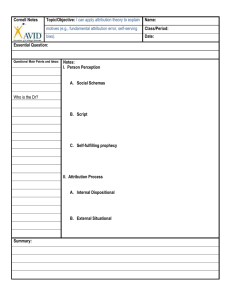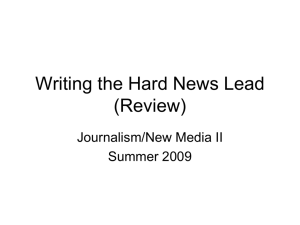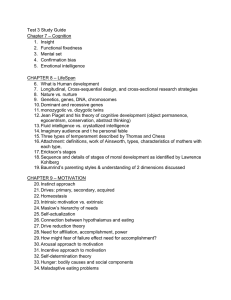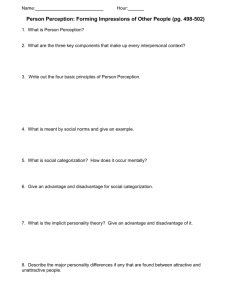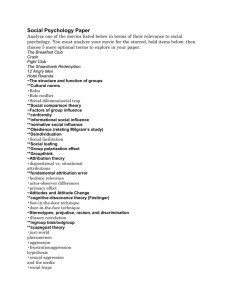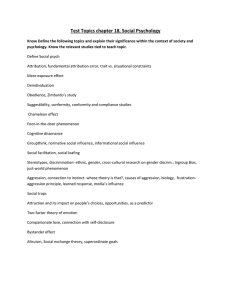T REPORT BRIEF IN
advertisement
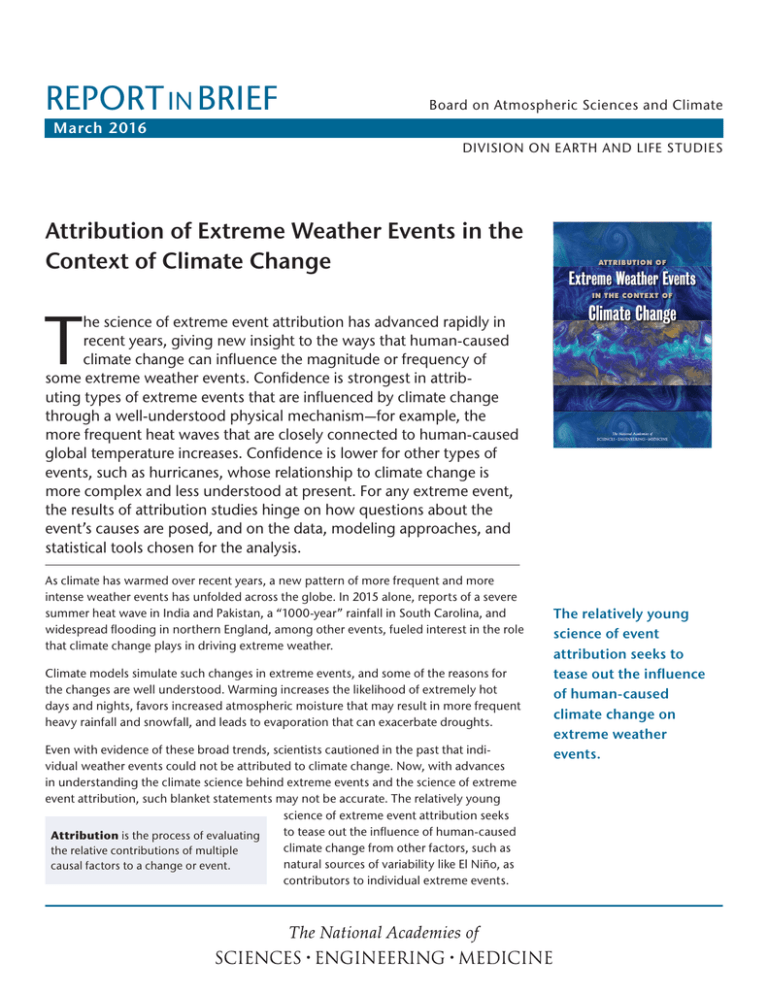
REPORT IN BRIEF Board on Atmospheric Sciences and Climate March 2016 DIVISION ON E ARTH AND LIFE STUDIES Attribution of Extreme Weather Events in the Context of Climate Change T he science of extreme event attribution has advanced rapidly in recent years, giving new insight to the ways that human-caused climate change can influence the magnitude or frequency of some extreme weather events. Confidence is strongest in attributing types of extreme events that are influenced by climate change through a well-understood physical mechanism—for example, the more frequent heat waves that are closely connected to human-caused global temperature increases. Confidence is lower for other types of events, such as hurricanes, whose relationship to climate change is more complex and less understood at present. For any extreme event, the results of attribution studies hinge on how questions about the event’s causes are posed, and on the data, modeling approaches, and statistical tools chosen for the analysis. As climate has warmed over recent years, a new pattern of more frequent and more intense weather events has unfolded across the globe. In 2015 alone, reports of a severe summer heat wave in India and Pakistan, a “1000-year” rainfall in South Carolina, and widespread flooding in northern England, among other events, fueled interest in the role that climate change plays in driving extreme weather. Climate models simulate such changes in extreme events, and some of the reasons for the changes are well understood. Warming increases the likelihood of extremely hot days and nights, favors increased atmospheric moisture that may result in more frequent heavy rainfall and snowfall, and leads to evaporation that can exacerbate droughts. Even with evidence of these broad trends, scientists cautioned in the past that individual weather events could not be attributed to climate change. Now, with advances in understanding the climate science behind extreme events and the science of extreme event attribution, such blanket statements may not be accurate. The relatively young science of extreme event attribution seeks to tease out the influence of human-caused Attribution is the process of evaluating climate change from other factors, such as the relative contributions of multiple natural sources of variability like El Niño, as causal factors to a change or event. contribu­tors to individual extreme events. AT T RI B UT I ON OF Extreme Weather Events I N T H E CO NTE XT OF Climate Change The relatively young science of event attribution seeks to tease out the influence of human-caused climate change on extreme weather events. Attributing a weather event to climate change does not mean that storms or heat waves would not have occurred without humans. All weather events result from a combination of both natural and human-influenced factors that together produce the specific conditions for a particular event. Event attribution can answer questions about how much climate change influenced the probability or intensity of a specific type of weather event. As event attribution capabilities improve, they could help further inform choices about assessing and managing risk, and in guiding climate adaptation strategies. This report examines the current state of science of extreme weather attribution, and identifies ways to move the science forward to improve attribution capabilities. SOME EXTREME EVENTS ARE MORE ATTRIBUTABLE THAN OTHERS The ability to attribute some extreme event types has advanced rapidly over recent years, while the attribution of other event types remains challenging. In general, event attribution is more reliable when based on a combination of sound physical principles, consistent evidence from observations, and numerical models that can replicate the event (see Figure 1). In particular, confidence in attribution findings of anthropogenic influence is greatest for those extreme events that are related to an aspect of temperature, such as the observed long-term warming of the regional or global climate, where there is little doubt that human activities have caused an observed change (see Figure 2). The influence of non-climate related factors, such as resource management actions or Box 1. Current Scientific Confidence in Attribution Results Varies for Different Types of Extreme Event Capabilities of Climate Models to Simulate Event Class Quality/ Length of the Observational Record Understanding of Physical Mechanisms that Lead to Changes in Extremes as a Result of Climate Change Tropical cyclones Extratropical cyclones Wildfire Severe convective storms = high = medium = low Extreme cold events Extreme heat events Drought Extreme rainfall Extreme snow Figure 1. Overall confidence in event attribution is strongest for extreme event types that are adequately simulated in climate models, have a long-term historical record of observations, and are linked to human-caused climate change through an understood and robustly simulated physical mechanism. The entries in this table, which are presented in approximate order of overall confidence, are based on the available literature and are the product of committee deliberation and judgement. Figure 2. Confidence in attribution is higher for events such as more frequent heat waves and less frequent cold snaps, which are linked to human-caused increases in global temperatures through an understood and robustly simulated physical mechanism. There is less confidence in the attribution of other types of events, such as tropical cyclones, that are related to climate change in more complex and less understood ways. infrastructure in the surrounding area, can complicate attribution studies. For example, many studies have linked an increase in wildfires to climate change, but the risk of any individual fire could depend on past forest management, natural climate variability, human activities in the forest, and other factors, in addition to any exacerbation by human-caused climate change. about the impact of climate change on extreme events as a whole. The events selected for attribution studies are not a representative sample of all the extreme events that take place around the world—there is more focus on events that affect areas with high populations and extensive infrastructure, and less focus on events that are becoming less frequent because of climate change, such as cold extremes. ASKING THE RIGHT QUESTIONS: THE WAY ATTRIBUTION QUESTIONS ARE POSED INFLUENCES HOW THEY ARE ANSWERED Statements about attribution are sensitive to the way the questions are posed and the context within which they are posed. The results hinge on how the extreme event is defined, the specific questions posed, the assumptions made when analyzing the event and the data, and the modeling and statistical tools used for the analysis. Unambiguous interpretation of an event attribution study is only possible when the assumptions and choices that were made in conducting the study are clearly stated, and uncertainties are carefully estimated. THE PATH FORWARD: IMPROVING EXTREME EVENT ATTRIBUTION CAPABILITIES A focused effort to improve specific aspects of weather and climate extremes research—particularly those areas that are presently poorly understood—would help increase the reliability of event attribution. This will require improvements in observations, models, theoretical understanding of the links between climate change and extremes, and analysis techniques. A definitive answer to the commonly asked question of whether climate change “caused” a particular event to occur cannot usually be provided in a deterministic sense because natural variability almost always plays a role. Many conditions must align to set up a particular event. Event attribution studies generally estimate how the intensity or frequency of an event or class of events has been altered by climate change (or by another factor). Thus, the scientific community would be better able to address questions such as: • Are events of this severity becoming more or less likely because of climate change? • To what extent was the storm intensified or weakened, or its precipitation increased or decreased, because of climate change? Bringing multiple scientifically appropriate approaches together, including multiple models and multiple studies, helps distinguish results that are robust from those that are more sensitive to how the question is posed and the approach taken. Robust attribution analyses typically show that the results are qualitatively similar even when the event is defined in different ways. Using multiple methods to estimate the human influence on a given event can help address the challenge of characterizing the many sources of uncertainty in event attribution. The committee noted that attribution studies of individual events should not be used to draw general conclusions A scientific researcher would re-pose the question “Was Hurricane Sandy caused by climate change?” as “Did human-caused climate change increase the odds that a hurricane as intense as Sandy took place in 2012?” Because event attribution is a relatively young field of study, standards have not yet been established for presenting results. Event attribution could be improved by the development of transparent, community standards for attributing classes of extreme events. Such standards could include an assessment of model quality in relation to the event class, or the use of multiple lines of evidence, and clear communication of sensitivities of the result to how event attribution questions are framed. Systematic criteria for selecting the events to be studied would minimize selection bias and permit systematic evaluation of attribution performance, which is important for enhancing confidence in attribution results. Studies of a representative sample of extreme events would allow stakeholders to use such studies as a tool for understanding how individual events fit into the broader picture of climate change. Box 2. Approaches to Event Attribution There are two classes of event attribution approaches: • those that rely on the observations to determine the change in probability or magnitude of events over the historical record; and • those that use model simulations to compare the manifestation of an event in a world with human-caused climate change to that in a hypothetical world without climate change. Most studies use both observations and models to some extent – for example, modeling studies will use observations to evaluate whether models reproduce the event of interest and whether the mechanisms involved correspond to observed mechanisms; and observational studies may rely on models for attribution of the observed change. dependent on framing. To investigate, researchers used an atmospheric general circulation model to produce hundreds of simulations of the climate of the 1960s (green circles) and of the 2000s (blue circles). Examining how likely it would be for conditions to exceed a given magnitude in a given year, the researchers concluded that the average observed temperature during July 2010 of nearly 25°C (solid black line; long-term observed average July temperature is represented by the dashed black line) was significantly more likely to occur in the 2000s than in the 1960s. This corresponded to a shift, represented by the downward black arrow, from a 99-year return time (a 1-in-99 chance of reaching the July 2010 temperature) in the 1960s, to a 33-year return time (a 1-in-33 chance) in the 2000s, indicating that climate change influenced the odds of the heat wave taking place. Figure 3. Western Russia experienced several heat waves in summer 2010, leading to average temperatures in July 2010 that exceeded the long-term observed average by more than 5 degrees Celsius. The heat waves were induced by unusually persistent atmospheric high pressure systems that could have been exacerbated by human-caused warming, but may have caused heat waves nonetheless. Attribution in such a case is heavily EVENT ATTRIBUTION IN AN OPERATIONAL CONTEXT As more researchers begin to focus on event attribution, their efforts would benefit from coordination to make sure there is a systematic approach and that uncertainties are explored across methods and framing. Some research groups are moving toward the development of operational event attribution systems, which would allow researchers to evaluate the causes of extreme events based on predefined and tested methods. However, framing the attribution question differently—this time to investigate chance that a heat wave with a 33-year return time would reach the magnitude of the 2010 heat wave in the 1960s, compared to the 2000s—changed the way the results could be interpreted. The researchers found only a small increase in the expected magnitude of a heat wave with a 33-year return time in the 2000s, compared to that in the 1960s (horizontal black arrow). Source: Friederike Otto, adapted from Otto et al., 2012. Some future event attribution activities could benefit from being linked to an integrated weather-to-climate forecasting effort on a range of timescales. Ultimately the goal would be to provide predictive forecasts of future extreme events at lead times of days to seasons, or longer, accounting for natural variability and anthropogenic influences. Because the forecasts would be verified and evaluated compared to observed events over time, they could help researchers improve models and build a stronger understanding of the physical mechanisms that relate human-caused climate change to extreme events. Locate information on related reports at http://dels.nas.edu/basc Download (free) or purchase this report at www.nap.edu Committee on Extreme Weather Events and Climate Change Attribution: David W. Titley (Chair), Pennsylvania State University, University Park; Gabriele Hegerl, University of Edinburgh, UK; Katharine L. Jacobs, University of Arizona, Tucson; Philip W. Mote, Oregon State University, Corvallis; Christopher J. Paciorek, University of California, Berkeley; J. Marshall Shepherd, University of Georgia, Athens; Theodore G. Shepherd, University of Reading, UK; Adam H. Sobel, Columbia University, New York, NY; John Walsh, University of Alaska, Fairbanks; Francis W. Zwiers, University of Victoria, BC, Canada; Katherine Thomas (Program Officer), Lauren Everett (Program Officer), Amanda Purcell (Associate Program Officer), Rita Gaskins (Administrative Coordinator), Erin Markovich (Program Assistant), National Academies of Sciences, Engineering, and Medicine The National Academies of Sciences, Engineering, and Medicine appointed the above committee of experts to address the specific task requested by Department of Energy, the Heising Simons Foundation, the Litterman Family Foundation, the David and Lucile Packard Foundation, the National Aeronautics and Space Administration, the National Oceanic and Atmospheric Administration, and the National Academy of Sciences. The members volunteered their time for this activity; their report is peer-reviewed and the final product signed off by both the committee members and the Academies. This report brief was prepared by the Academies based on the committee’s report. For more information, contact the Board on Atmospheric Sciences and Climate at (202) 334-3512 or visit at http://dels.nas.edu/basc. Copies of Attribution of Extreme Weather Events in the Context of Climate Change are available from the National Academies Press, 500 Fifth Street, NW, Washington, DC 20001; (800) 624-6242; or as free PDFs at www.nap.edu. Permission granted to reproduce this brief in its entirety with no additions or alterations. Permission for images/figures must be obtained from their original source. © 2016 The National Academy of Sciences
